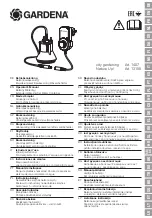
WavePro 7Zi
423
WP700Zi-OM-E-RevA
The processes that make up jitter are complex and come from many different random and non-random
(deterministic) sources. The PDF of the jitter is the convolution of all individual component PDF’s. Measurements
are able to estimate the jitter PDF but are not able to determine the distributions of the random and deterministic
parts of the overall distribution. The lack of exact measurements for the jitter distributions of Rj and Dj has lead to
the use of a simplified model for the total jitter. Equation 1 describes this model which was first presented in the
Fibrechannel MJSQ document.
Equation 1 is a heuristic that describes total jitter as a function of bit error rate (BER) and is related to a
distribution consisting of a Gaussian convolved with a pair of impulses as shown in
Figure 7
. The constants Rj
and Dj represent all of the components of random and deterministic jitter. The Greek letter Psi is a function of
BER and represents the total peak-to-peak jitter of a unit normal distribution (i.e., a Gaussian with zero mean and
a standard deviation of 1 at the specified bit error rate. The process of determining Rj and Dj involves finding the
“best fit” values that solve equation 1. There are many possible ways to fit Rj and Dj to (1) and since it is a
simplification, no single set of solutions can completely describe the behavior of actual jitter completely. It is for
this reason that the SDA uses two separate methods to measure Rj and Dj, effective and direct, and presents
these to the user.
Figure 5-37. Jitter PDF model corresponding to the heuristic in equation 1. The random jitter is modeled
by a Gaussian and the deterministic jitter by a pair of impulses separated by the value of the parameter
Dj. The curve shown is the convolution of Rj and Dj.
Bit Error Rate and Jitter
Equation 1
shows that the total jitter is a function of bit error rate. This relationship is based on the effect that jitter
has on the bit error rate of a system. The bit error rate is influenced by other parameters of the system, such as
noise, so it is not correct to say that BER and jitter are equivalent. It is the contribution to the overall bit error rate
caused by jitter that is shown in
Equation 1
. A bit error will occur when the data signal transitions from one state to
another during the setup and hold time, as shown in
Figure 6
. Since jitter has a random component, the location
in time of the transitions varies over a range of values. The longer the transitions are observed, the greater this
range will be. Now, if we think of each transition in the data signal as the change in a bit value, then a transition at
the wrong time (i.e., outside the setup and hold window) will lead to a bit error. The probability of this event is
equivalent to the bit error rate contribution due to jitter. The total jitter gives a confidence interval for the jitter in
that it will not exceed a certain value to a confidence of (1-BER). The term “bit error rate” is commonly used in this
context to refer to the jitter confidence interval in many specifications.
EyeBER
differs from BER in that eyeBER is calculated from
Q-factor
and is, therefore, based on signal-to-noise
ratio; BER, on the other hand, is based on jitter.
Содержание DDA 7 Zi series
Страница 1: ...Operator s Manual WavePro SDA and DDA 7 Zi Series Oscilloscopes ...
Страница 2: ... L R R H HUD RU D D ...
Страница 41: ...Operator s Manual WP700Zi OM E RevA 40 The detachable WavePro Zi front panel ...
Страница 376: ...WavePro 7Zi 375 WP700Zi OM E RevA Absolute Offset Relative ...
Страница 439: ...Operator s Manual WP700Zi OM E RevA 438 ...
Страница 440: ...WavePro 7Zi 439 WP700Zi OM E RevA ...
Страница 544: ...Thank you for purchasing a WavePro SDA or DDA 7 Zi Oscilloscope ...
















































